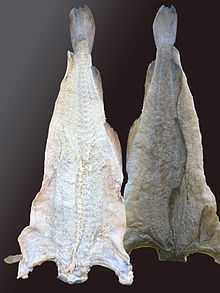Bacalhau


Bacalhau (Portuguese pronunciation: [bɐkɐˈʎaw]) is the Portuguese word for cod and—in a culinary context—dried and salted cod. Fresh (unsalted) cod is referred to as bacalhau fresco (fresh cod).
Portuguese and other cuisines
Bacalhau dishes are common in Portugal and Galicia, in the northwest of Spain, also common in former Portuguese colonies like Cape Verde, Angola, Macau, Brazil, and Goa. There are said to be over 1000 recipes in Portugal alone and it can be considered the iconic ingredient of Portuguese cuisine (but curiously the only fish that is not consumed fresh in this fish-loving nation). It is often cooked on social occasions and is the Portuguese traditional Christmas dinner in some parts of Portugal.
Similar recipes can be found across Europe. It is also found in the cuisines of other territories and regions like Dominican Republic and Puerto Rico. In Norway, where most of the salted and dried cod is produced, bacalao commonly refers to a specific dish prepared with salted and dried cod, potatoes, onions, tomatoes and olives. In recent years, there has also been increasing interest in the wider range of Portuguese dishes based on dried and salted cod, however.
Salted, dried cod, usually comes from Norway (bacalhau da Noruega), Iceland (bacalhau da Islândia) or Newfoundland (bacalhau da Terra Nova). It used to be very affordable, but with the collapse of the cod stocks and dismantling of Portuguese bacalhoeiro fleet, it became more expensive, especially near Easter and Christmas time, since it is a part of many traditional dishes of the holiday season.
Bacalhau is also used to flavor a vegetable, dumpling and fish stew known as "Dhokras".
Cuisine
There are numerous bacalhau recipe variations, depending on region and tradition.In Portugal, it is said there are more than 365 ways to cook bacalhau, one for every day of the year; others say there are 1,001 ways. Whatever the exact number, bacalhau is a ubiquitous ingredient in Portuguese cuisine.
Bacalhau is often served with potatoes. Green (Vinho Verde) or mature wines (Alentejo Wine, Dão Wine, or Douro Wine) are served alongside.

Some Bacalhau dishes:
- Bacalhau com todos
- Bacalhau à Gomes de Sá (some varieties: Original, Porto)
- Bacalhau à Brás
- Bacalhau à Zé do Pipo
- Bacalhau com natas (Bacalhau with cream)
- Bolinhos de Bacalhau
- Bacalhau no Forno com Cebolada
- Bacalhau Suado à Lisboa
History
Salt cod has been produced for at least 500 years, since the time of the European discoveries of the New World. Before refrigeration, there was a need to preserve the cod; drying and salting are ancient techniques to preserve nutrients and the process makes the cod tastier.
The Portuguese tried to use this method of drying and salting on several varieties of fish from their waters, but the ideal fish came from much further north. With the "discovery" of Newfoundland in 1497, long after the Basque whalers arrived in Channel-Port aux Basques, they started fishing its cod-rich Grand Banks. Thus, bacalhau became a staple of the Portuguese cuisine, nicknamed Fiel amigo (faithful friend). From the 18th century, the town of Kristiansund in Norway became an important place of purchasing bacalhau or klippfisk (literally "cliff fish", since the fish was dried on stone cliffs by the sea to begin with). Since the method was introduced by the Dutchman Jappe Ippes in about 1690, the town had produced klippfisk and when the Spanish merchants arrived, it became a big industry. The bacalhau or bacalao dish is sometimes said to originate from Kristiansund, where it was introduced by the Spanish and Portuguese fish buyers and became very popular. Bacalhau was common everyday food in north west Norway to this day, as it was cheap to make. In later years it is more eaten at special occasions.
This dish was also popular in Portugal and other Roman Catholic countries, because of the many days (Fridays, Lent, and other festivals) on which the Church forbade the eating of meat. Bacalhau dishes were eaten instead.[1]
Bacalhau is also popular in Sfax where this dish is eaten in the first day of Eid ul-Fitr with charmoula.
See also
References
| ||||||||||
| ||||||||||||||